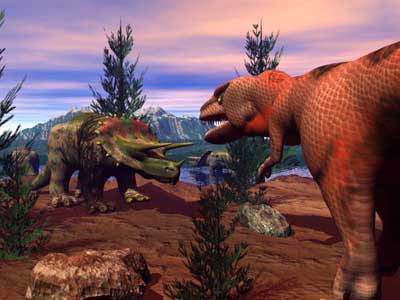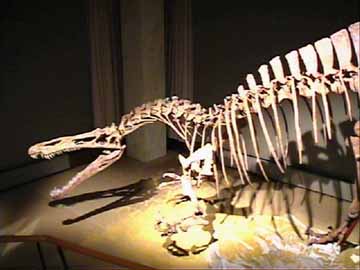pop up description layer
HOME
Cryptozoology UFO Mysteries Aviation Space & Time Dinosaurs Geology Archaeology Exploration 7 Wonders Surprising Science Troubled History Library Laboratory Attic Theater Store Index/Site Map Cyclorama
Search the Site: |
|
Was the Tyrannosaurus Really So Terrible?
He's 40 feet long, 18 feet high, weighs six tons and has a four-foot-long mouth filled with sharp teeth seven inches long. What's more, he can chase his prey across an open plain at speeds of forty miles per hour and when he catches his victim, one bite from his massive jaws can break their backbones. His name means tyrant lizard king and he is the most feared predator that ever lived: Tyrannosaurus Rex. Well, maybe. Scavenger? Despite his impressive height, weight and length, some scientists, including paleontologist Jack Horner, think that the T-Rex, a huge, therapod dinosaur from the Cretaceous period, didn't chase down its prey at all, but was merely a scavenger. As a scavenger he fed off of already dead animals, killed by old age, disease, or other carnivores, to get his meals. Dr. Horner points out that some of today's largest birds, like the vulture, are scavengers (Birds are thought to be the dinosaurs' closest living relatives). Proponents of the scavenger theory also note that the T-Rex's scrawny front arms seem inadequate to hold a victim during an attack (Others point out some creatures, like the great white shark, are successful predators even with no arms at all). Horner also thinks T-Rex's legs were optimized for walking, rather than running prey to ground. He probably followed a large herd of animals, like Triceratops, waiting for one of them to keel over. Fossil examination show that the T-Rex's olfactory lobes (the part of the brain that handles smell) were huge. On one fossil specimens they were found to be as large as grapefruits. These huge lobes suggest that a Tyrannosaurus might be able to smell a rotting carcass, his next meal, from miles away.
Also, the Tyrannosaurus' height and size might have been more useful for seeing long distances to find his meals and chasing off other dinosaurs competing for a carcass rather than for hunting live prey. Other scientists argue that scavenging for food and hunting aren't mutually exclusive activities and T-Rex might have done both depending on what was easiest. Such is the case with lions in modern Africa. They hunt when they have to, but are happy to steal a carcass from a smaller predator, like the hyena, when they can. The Big Bite One thing for certain about Tyrannosaurus is that they fought fiercely among themselves. Several Tyrannosaurus skeletons have been found with wounds made during attacks by other T-Rex's. It is clear that since some of the wounds had healed they weren't the result of scavenging after death. The clashes were probaby over food or territory. With the strength a T-Rex has in his jaws, the loser must have walked away in considerable pain. According to Gregory Erickson, T-Rex had an incredibly powerful bite. Erickson, a researcher with University of California at Berkeley, reproduced the results of a Tyrannosaurus bite by using a bronze-aluminum cast of a tooth in a hydraulic press. By comparing the damage the fake tooth did to a cow pelvic bone with a fossil Triceratops bone that had T-Rex marks, Erickson estimated that the Tyrannosaurus was able to bite with a force of 3,000 pounds. That's the equivalent of a pickup truck sitting on top of each tooth. Erickson thinks T-Rex was capable of even a much stronger bites during an attack. The marks on the Triceratops were only a "feeding bite," not meant to kill. Not So Fast
Two other researchers, James Farlow and John Robinson, have made some calculations about T-Rex's speed that may support Horner's scavenging theory. According to Farlow and Robinson, if a full-sized T-Rex running at 40 miles per hour tripped, the result would be catastrophic. Weighing as much as he did, the dinosaur would hit the ground with tremendous force probably cracking his skull, squashing his internal organs and finally, at the end of a fifty foot skid, breaking his neck. Even at a more conservative 25 miles per hour, which Farlow and Robinson think was really the T-Rex's upper limit, the damage would still be considerable. They estimate T-Rex rarely went more than fifteen miles per hour because of the danger of falling. If they are right, their ideas tend to support Horner's scavenger theory. At fifteen miles per hour, T-Rex might find it hard to keep up with smaller and faster dinosaurs that might make a good lunch. Still Bad, But Maybe Not the Biggest
T-Rex may even find his claim to being the largest meat-eating dinosaur in question. Paul Sereno, a paleontologist from the University of Chicago, has unearthed a giant 50 foot long predator that lived 90 million years ago in what is now Africa. Carcharodontosaurus saharicus, which means "shark-toothed reptile of the Sahara", had been named for many years. Little was known about it, however, as the single specimen found was destroyed while it was being studied in Germany during World War II. Sereno's beast, dug out of the ground in the Moroccan Sahara, appears to be larger than any known specimen of Tyrannosaurus Rex ever found.
Another rival for the largest dinosaur carnivore is Spinosaurus. Paleontologists think this giant, whose fossils have been found in northern Africa, was as long as fifty-nine feet and weighed 9 tons. The most spectacular feature of Spinosaurus just wasn't his great size, however, but a six-foot tall "sail" or hump that ran along his back. Spinosaurus was featured in the movie, "Jurassic Park III," where it fought and killed a T-Rex. Though speculating about such a battle is fun, it would not have happened. Though Spinasaurus and T-Rex both lived during the late Cretaceous Era they were still separated by over twenty million years in time. They also lived on two different continents. Spinosaurus is currently thought to be the biggest dinosaur predator that ever lived. Another dinosaur bigger than T-rex was Giganotosaurus. Giganotosaurus lived in South America during the Cretaceous era and was one of the biggest land-dwelling meat eaters to ever walk the face of the earth. Giganotosaurus, whose name means "Giant southern lizard," grew as long as 43 feet and weighed between 6.5 and 13.3 tons. Though Giganotosaurus seems to have filled the same niche in the South American eco-system as Tyrannosaurus in North America, paleontologists think that they were in no way related.
A Partial Bibliography The Ultimate Dinosaurs, Edited by Katie Orchard, Parragon Books, 2000. Dinosaur Heresies, by Robert T. Bakker, Ph.D., William Morrow and Company, 1986. The Complete T-Rex, by John R. Horner and Don Lesson, Simon & Schuster, 1993. Copyright Lee Krystek 1996-2003. All Rights Reserved. |
|
Related Links |
|
|






 More about T-Rex from UC at Berkeley
More about T-Rex from UC at Berkeley